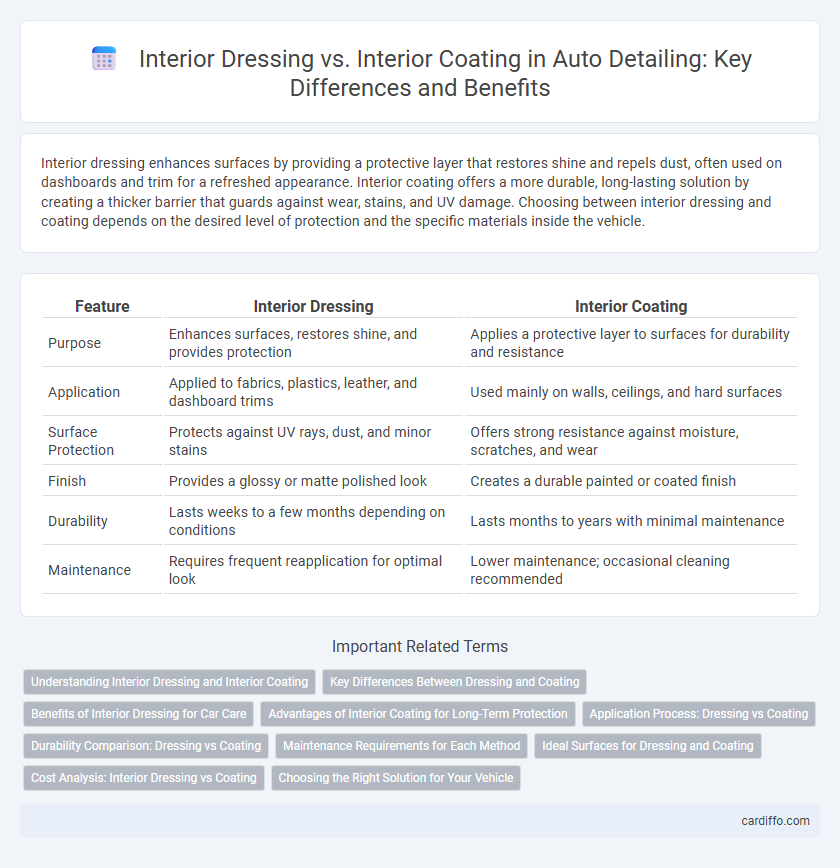Interior dressing enhances surfaces by providing a protective layer that restores shine and repels dust, often used on dashboards and trim for a refreshed appearance. Interior coating offers a more durable, long-lasting solution by creating a thicker barrier that guards against wear, stains, and UV damage. Choosing between interior dressing and coating depends on the desired level of protection and the specific materials inside the vehicle.
Table of Comparison
| Feature | Interior Dressing | Interior Coating |
|---|---|---|
| Purpose | Enhances surfaces, restores shine, and provides protection | Applies a protective layer to surfaces for durability and resistance |
| Application | Applied to fabrics, plastics, leather, and dashboard trims | Used mainly on walls, ceilings, and hard surfaces |
| Surface Protection | Protects against UV rays, dust, and minor stains | Offers strong resistance against moisture, scratches, and wear |
| Finish | Provides a glossy or matte polished look | Creates a durable painted or coated finish |
| Durability | Lasts weeks to a few months depending on conditions | Lasts months to years with minimal maintenance |
| Maintenance | Requires frequent reapplication for optimal look | Lower maintenance; occasional cleaning recommended |
Understanding Interior Dressing and Interior Coating
Interior dressing involves applying protective and decorative treatments to enhance surfaces such as walls, furniture, or trim, using materials like varnishes, stains, or waxes to preserve texture and appearance. Interior coating refers to the application of paint or specialized coatings designed to protect interior surfaces from wear, moisture, and environmental damage while providing color and finish variations. Both processes improve interior aesthetics and durability but differ in composition, purpose, and the type of surface enhancement they achieve.
Key Differences Between Dressing and Coating
Interior dressing primarily enhances the appearance and texture of surfaces by adding a protective layer that helps maintain cleanliness and restore shine, typically used on leather, plastic, or vinyl. Interior coating involves applying a more durable, often chemical-based layer designed to provide long-lasting protection against wear, UV damage, and stains on materials like fabric or trim. The key difference lies in durability and function: dressing improves aesthetics and immediate surface condition, while coating offers extended protection and resistance.
Benefits of Interior Dressing for Car Care
Interior dressing enhances the longevity and appearance of car surfaces by providing a protective barrier against UV rays, dust, and stains, which prevents cracking and fading. It restores the original sheen and texture of dashboards, door panels, and leather seats, maintaining a like-new interior look. Regular application of interior dressing promotes cleanliness and preserves the value of the vehicle by preventing premature wear and tear.
Advantages of Interior Coating for Long-Term Protection
Interior coating provides superior long-term protection by creating a durable barrier that resists moisture, stains, and wear, significantly extending the lifespan of interior surfaces. Unlike interior dressing, which primarily enhances appearance temporarily, interior coating offers enhanced resistance to scratches, fading, and chemical damage, reducing the frequency of maintenance. Advanced interior coating technologies, such as polyurethane or epoxy-based products, deliver robust surface sealing that maintains aesthetic appeal while protecting structural integrity over time.
Application Process: Dressing vs Coating
Interior dressing involves applying a liquid or gel product to surfaces like dashboards and leather to restore shine and protect against UV damage, typically using cloths or applicator pads for even distribution. Interior coating requires a more technical process that includes surface cleaning, preparing, and applying a thin, durable layer of protective material, often cured or dried to form a resistant barrier against stains and wear. Dressing is generally easier and faster to apply, while coating demands precise application techniques and curing time for long-lasting results.
Durability Comparison: Dressing vs Coating
Interior dressing enhances surface protection by penetrating and conditioning materials, providing moderate durability against wear and UV exposure. Interior coating forms a protective film on surfaces, offering superior resistance to scratches, stains, and prolonged environmental damage. Coatings generally deliver longer-lasting durability compared to dressings, especially in high-traffic or harsh-use interior environments.
Maintenance Requirements for Each Method
Interior dressing involves applying protective products like leather conditioners or fabric sealants that require regular reapplication every 3 to 6 months to maintain optimal protection and appearance. Interior coating, such as ceramic or polymer coatings, offers a more durable and long-lasting shield against stains and UV damage, often lasting up to 1 to 3 years with minimal upkeep. Maintaining interior coatings typically involves routine cleaning with pH-neutral products, reducing the frequency and intensity of maintenance compared to interior dressing methods.
Ideal Surfaces for Dressing and Coating
Interior dressing is ideal for porous surfaces such as leather, fabric, and wood, enhancing texture and providing deep nourishment without altering the material's natural appearance. Interior coating suits harder, non-porous surfaces like plastic, metal, and painted walls, offering a durable protective layer that resists wear and moisture. Selecting the appropriate treatment depends on surface composition to maximize durability and aesthetic enhancement.
Cost Analysis: Interior Dressing vs Coating
Interior dressing generally incurs higher costs than interior coating due to the use of premium materials such as leather, fabric, or wood veneers, which demand skilled labor for precise application. Interior coating involves applying paint, varnish, or protective layers that are more affordable and quicker to apply, reducing overall expenses. Budget considerations favor interior coating for cost-efficiency, while interior dressing offers luxurious aesthetics at a premium price point.
Choosing the Right Solution for Your Vehicle
Interior dressing enhances your vehicle's surfaces by restoring shine and maintaining leather, vinyl, or plastic materials, offering protection against UV damage and wear. Interior coating provides a durable, often ceramic-based layer that seals and protects surfaces from stains, spills, and fading for long-lasting preservation. Selecting between interior dressing and coating depends on your vehicle's material condition and desired maintenance frequency, with dressing favored for routine upkeep and coating ideal for robust, extended protection.
Interior Dressing vs Interior Coating Infographic

 cardiffo.com
cardiffo.com